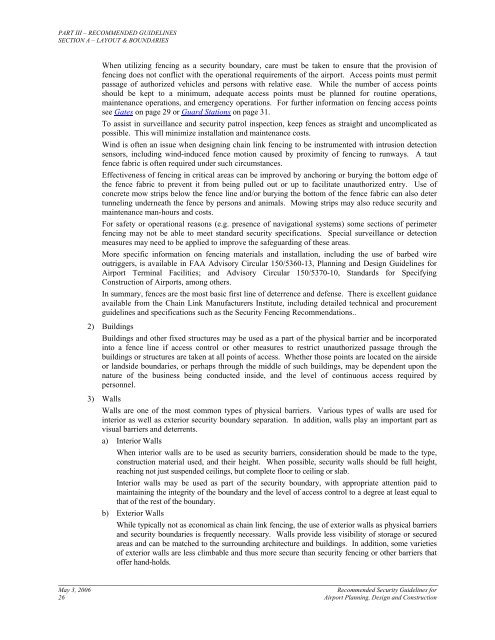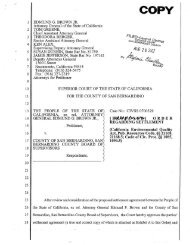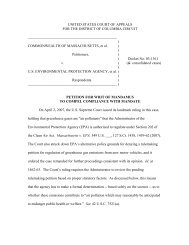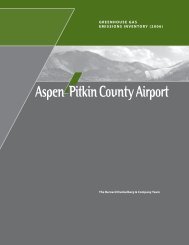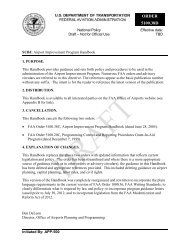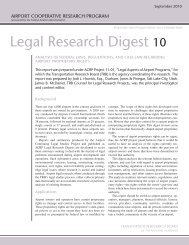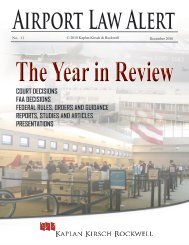TSA Recommended Security Guidelines for Airport ... - ACConline.org
TSA Recommended Security Guidelines for Airport ... - ACConline.org
TSA Recommended Security Guidelines for Airport ... - ACConline.org
Create successful ePaper yourself
Turn your PDF publications into a flip-book with our unique Google optimized e-Paper software.
PART III – RECOMMENDED GUIDELINES<br />
SECTION A – LAYOUT & BOUNDARIES<br />
When utilizing fencing as a security boundary, care must be taken to ensure that the provision of<br />
fencing does not conflict with the operational requirements of the airport. Access points must permit<br />
passage of authorized vehicles and persons with relative ease. While the number of access points<br />
should be kept to a minimum, adequate access points must be planned <strong>for</strong> routine operations,<br />
maintenance operations, and emergency operations. For further in<strong>for</strong>mation on fencing access points<br />
see Gates on page 29 or Guard Stations on page 31.<br />
To assist in surveillance and security patrol inspection, keep fences as straight and uncomplicated as<br />
possible. This will minimize installation and maintenance costs.<br />
Wind is often an issue when designing chain link fencing to be instrumented with intrusion detection<br />
sensors, including wind-induced fence motion caused by proximity of fencing to runways. A taut<br />
fence fabric is often required under such circumstances.<br />
Effectiveness of fencing in critical areas can be improved by anchoring or burying the bottom edge of<br />
the fence fabric to prevent it from being pulled out or up to facilitate unauthorized entry. Use of<br />
concrete mow strips below the fence line and/or burying the bottom of the fence fabric can also deter<br />
tunneling underneath the fence by persons and animals. Mowing strips may also reduce security and<br />
maintenance man-hours and costs.<br />
For safety or operational reasons (e.g. presence of navigational systems) some sections of perimeter<br />
fencing may not be able to meet standard security specifications. Special surveillance or detection<br />
measures may need to be applied to improve the safeguarding of these areas.<br />
More specific in<strong>for</strong>mation on fencing materials and installation, including the use of barbed wire<br />
outriggers, is available in FAA Advisory Circular 150/5360-13, Planning and Design <strong>Guidelines</strong> <strong>for</strong><br />
<strong>Airport</strong> Terminal Facilities; and Advisory Circular 150/5370-10, Standards <strong>for</strong> Specifying<br />
Construction of <strong>Airport</strong>s, among others.<br />
In summary, fences are the most basic first line of deterrence and defense. There is excellent guidance<br />
available from the Chain Link Manufacturers Institute, including detailed technical and procurement<br />
guidelines and specifications such as the <strong>Security</strong> Fencing Recommendations..<br />
2) Buildings<br />
Buildings and other fixed structures may be used as a part of the physical barrier and be incorporated<br />
into a fence line if access control or other measures to restrict unauthorized passage through the<br />
buildings or structures are taken at all points of access. Whether those points are located on the airside<br />
or landside boundaries, or perhaps through the middle of such buildings, may be dependent upon the<br />
nature of the business being conducted inside, and the level of continuous access required by<br />
personnel.<br />
3) Walls<br />
Walls are one of the most common types of physical barriers. Various types of walls are used <strong>for</strong><br />
interior as well as exterior security boundary separation. In addition, walls play an important part as<br />
visual barriers and deterrents.<br />
a) Interior Walls<br />
When interior walls are to be used as security barriers, consideration should be made to the type,<br />
construction material used, and their height. When possible, security walls should be full height,<br />
reaching not just suspended ceilings, but complete floor to ceiling or slab.<br />
Interior walls may be used as part of the security boundary, with appropriate attention paid to<br />
maintaining the integrity of the boundary and the level of access control to a degree at least equal to<br />
that of the rest of the boundary.<br />
b) Exterior Walls<br />
While typically not as economical as chain link fencing, the use of exterior walls as physical barriers<br />
and security boundaries is frequently necessary. Walls provide less visibility of storage or secured<br />
areas and can be matched to the surrounding architecture and buildings. In addition, some varieties<br />
of exterior walls are less climbable and thus more secure than security fencing or other barriers that<br />
offer hand-holds.<br />
______________________________________________________________________________________________<br />
May 3, 2006<br />
<strong>Recommended</strong> <strong>Security</strong> <strong>Guidelines</strong> <strong>for</strong><br />
26 <strong>Airport</strong> Planning, Design and Construction


